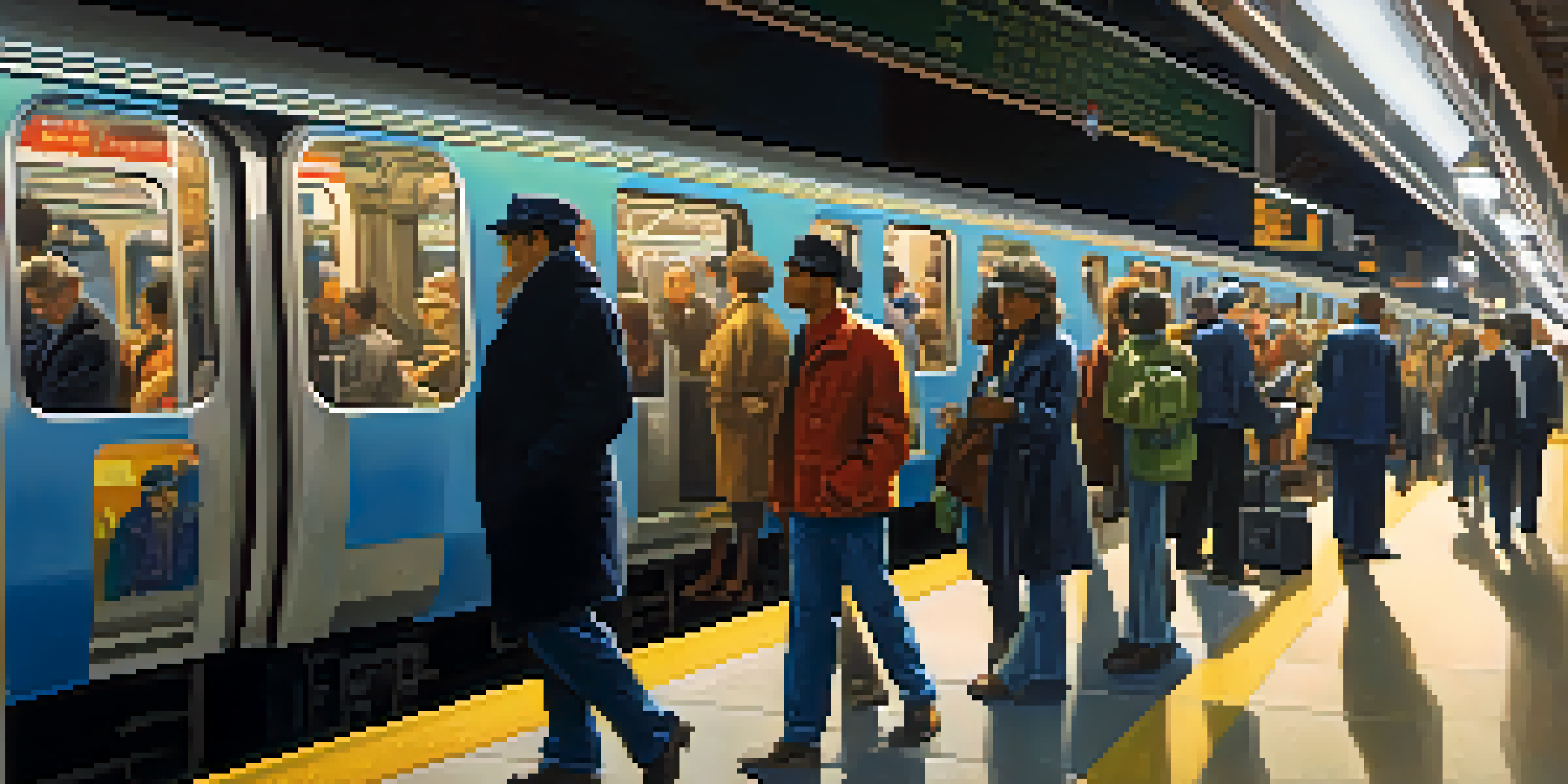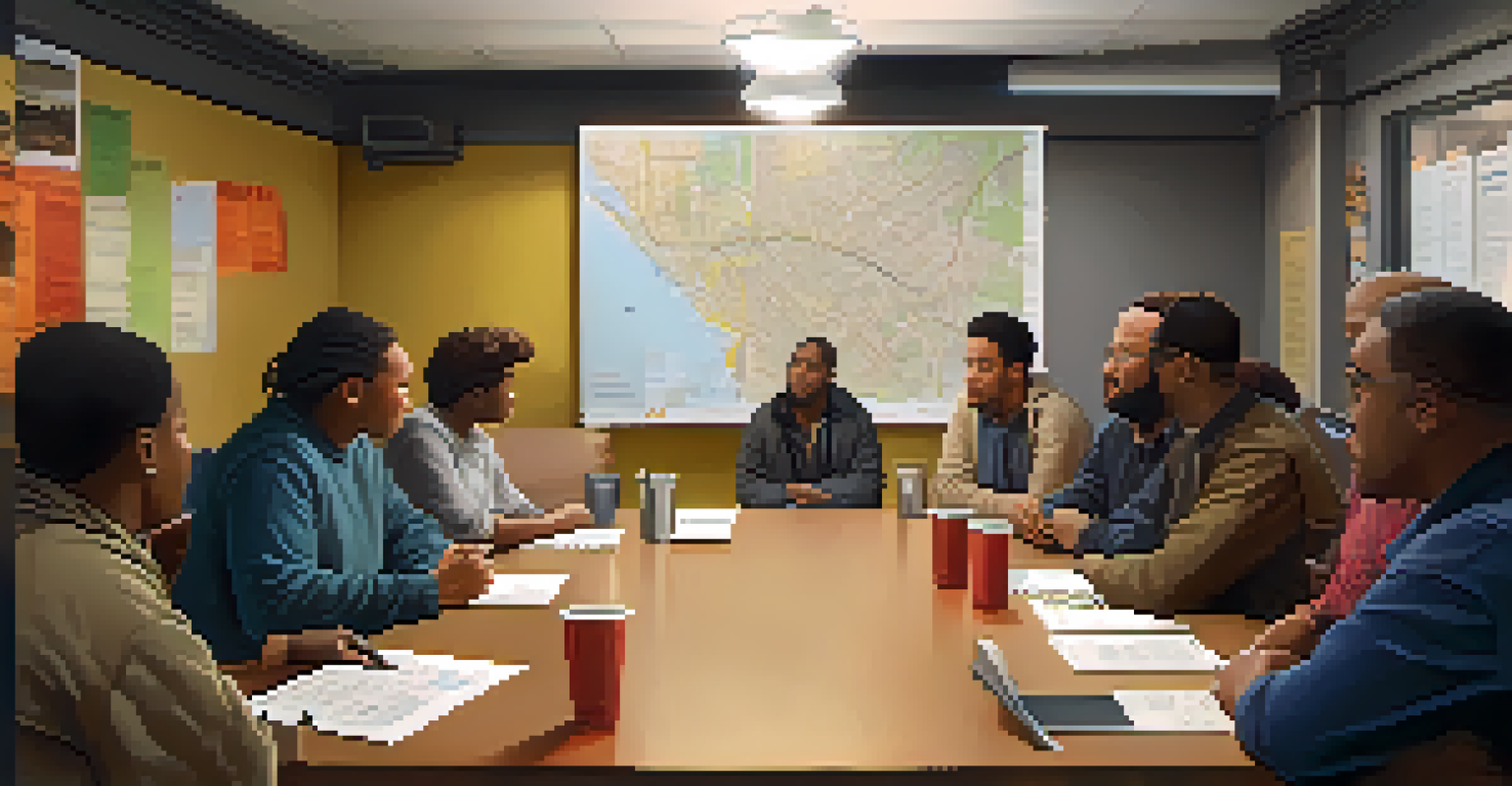Public Transportation Affordability and Equity in NYC

Understanding Public Transportation Affordability in NYC
Public transportation affordability in New York City is a pressing issue that affects millions of residents. With subway fares currently set at $2.75, many low-income families find it challenging to manage their commuting costs, especially when combined with other living expenses. This affordability challenge can create a significant barrier to accessing jobs, education, and essential services throughout the city.
Public transportation should be a right, not a privilege.
Moreover, the cost of transit affects different demographics in unique ways. For instance, public transit is often a lifeline for those living in outer boroughs who rely on it for daily commutes. This dependence means that when fares increase or service is limited, it disproportionately impacts those who are already struggling financially, making it harder for them to thrive in the bustling city environment.
Ultimately, understanding the nuances of public transportation affordability is crucial for addressing the broader issue of equity in NYC. As we delve deeper into the subject, we will uncover how these challenges intersect with race, class, and geography, and explore potential solutions to ensure fair access for all residents.
The Role of Equity in NYC's Transportation System
Equity in public transportation means ensuring that all individuals, regardless of their background, have equal access to transit services. In a city as diverse as New York, this becomes quite complex, as different neighborhoods experience varying levels of service and accessibility. For example, areas with higher income levels may enjoy frequent service, while low-income neighborhoods often face longer wait times and fewer options.

This inequity can lead to a cycle of disadvantage, where those in underserved areas struggle not only to reach employment opportunities but also to access essential resources like healthcare and education. The lack of reliable transit options can trap individuals in a cycle of poverty, making it difficult to break free and improve their circumstances.
Affordability Impacts Access
High public transportation costs in NYC create barriers for low-income families, limiting their access to jobs, education, and essential services.
Addressing equity in transportation requires more than just adjusting fares; it calls for a comprehensive review of how services are allocated across the city. By prioritizing the needs of marginalized communities, NYC can create a more inclusive public transit system that empowers all residents to participate fully in city life.
Current Challenges Facing NYC's Public Transportation
Despite being the backbone of the city's commuting infrastructure, NYC's public transportation system faces numerous challenges. Aging subway lines, frequent delays, and overcrowding are just a few issues that commuters encounter daily. These problems are exacerbated by the rising costs associated with maintaining and upgrading the system, which can lead to increased fares that impact affordability.
Equity means that we all have access to the same opportunities, regardless of where we live or how much we earn.
Additionally, the COVID-19 pandemic has shifted commuting patterns dramatically, leading to reduced ridership and revenue shortfalls. As many people work remotely or adjust their schedules, the transportation system must adapt to these changes while still serving those who rely on it. This evolving landscape presents a unique set of challenges for transit authorities trying to balance service levels with financial sustainability.
Moreover, climate change and sustainability concerns are increasingly influencing public transportation policies. As NYC aims to reduce its carbon footprint, ensuring that public transit remains a viable option for commuters becomes even more crucial. These challenges require innovative solutions that prioritize both affordability and environmental responsibility.
Impact of Fare Increases on Low-Income Communities
Fare increases can have a particularly harsh impact on low-income communities, who often rely on public transportation as their primary means of travel. For families already living paycheck to paycheck, even a small increase can mean difficult choices between transportation and other essential expenses, such as food or healthcare. This struggle reinforces the notion that public transit should be a right, not a privilege.
In many cases, fare hikes lead to decreased ridership among those who cannot afford to pay the new rates. This decline not only affects the financial health of the transit system but can also lead to service cuts, further limiting access for those who need it most. The cycle of increasing fares and decreasing ridership can create a feedback loop that perpetuates inequity in the transportation system.
Equity is Crucial for Transit
Ensuring equitable access to public transportation is vital for underserved communities, affecting their ability to reach employment and resources.
To mitigate these effects, some advocates propose implementing sliding-scale fares or providing subsidies for low-income riders. These solutions can help ensure that public transportation remains accessible to everyone, regardless of their financial situation, fostering a more equitable system overall.
Innovative Solutions for Affordable Public Transit
As NYC grapples with the challenges of public transportation affordability, innovative solutions are emerging to address these issues. One approach gaining traction is the introduction of community-based transit programs that cater specifically to the needs of underserved neighborhoods. These programs can help fill gaps in service and provide affordable options that directly respond to community demands.
Another solution involves expanding the use of technology to enhance the transit experience. Mobile apps that provide real-time information on bus and subway schedules can empower riders to make informed decisions about their journeys, reducing wait times and improving overall efficiency. This increased transparency can help restore trust in the system and encourage more people to use public transit.
Additionally, partnerships with local businesses and organizations can lead to fare discounts or transit vouchers for low-income individuals. By fostering collaboration among various stakeholders, NYC can create a more integrated approach to public transportation that prioritizes affordability and accessibility for all residents.
Community Advocacy and the Push for Change
Community advocacy plays a vital role in shaping the future of public transportation in NYC. Grassroots organizations and activists work tirelessly to highlight the needs of marginalized communities and push for policies that promote equity and affordability. Their voices are essential in ensuring that the concerns of low-income riders are not overlooked in planning and decision-making processes.
These advocacy efforts often manifest through campaigns aimed at raising awareness about transit inequities and demanding action from policymakers. From organizing rallies to participating in public forums, community members can mobilize support and influence change at both the local and citywide levels. By coming together, they create a powerful force that can challenge the status quo and drive meaningful reforms.
Innovative Solutions Needed
To improve public transit affordability, NYC must explore innovative solutions like community-based programs and technology enhancements.
Moreover, engaging with local representatives and participating in city meetings can help bridge the gap between community needs and transportation policies. By fostering open dialogue with decision-makers, advocates can ensure that the voices of those most affected by transportation inequities are heard and considered in future planning efforts.
Looking Ahead: The Future of Public Transit in NYC
As New York City moves forward, the future of public transportation will hinge on addressing the dual challenges of affordability and equity. The ongoing dialogue around these issues presents an opportunity for stakeholders to collaborate and develop innovative solutions that meet the diverse needs of the city's population. With the right strategies in place, NYC can create a transit system that works for everyone.
Investing in infrastructure improvements and expanding service to underserved areas will be critical in ensuring that all residents have reliable access to public transportation. This investment not only enhances the overall transit experience but also promotes economic growth and community development in areas that have historically been marginalized.

Ultimately, the goal is to foster a public transportation system that not only prioritizes efficiency and sustainability but also champions equity and accessibility. By envisioning a future where every New Yorker can travel freely and affordably, we can create a city that truly reflects the values of inclusivity and opportunity for all.